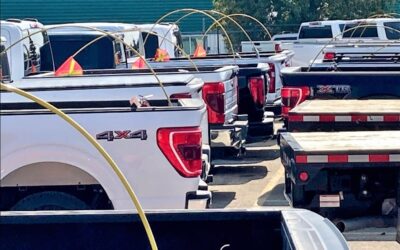A Guide to Fleet Vehicle Maintenance
It probably goes without saying, but when your vehicles aren’t operating, they’re not helping you grow your business. Unanticipated fleet repairs take your vital delivery and transportation resources out of circulation, leaving your people and your customers in the lurch. And in addition to the lost revenue from having a grounded fleet, fixing broken vehicles can be a significant drain on your company’s budget.
This is where fleet vehicle maintenance comes in.
Fleet maintenance and repair allow you to get ahead of unforeseen vehicle downtime by scheduling important care and upkeep tasks before minor issues can lead to major delays. At the same time, fleet vehicle maintenance helps keep your trucks, flatbeds, vans, etc. in top working condition, optimizing their effectiveness, efficiency, and safety.
Here, we take a look at the elements of fleet vehicle maintenance, and how the right fleet repair services and programs can help keep your business on the road.
Elements of a Fleet Vehicle Maintenance Program
To be effective, a fleet maintenance and repair program must be thorough. And whether you’re considering hiring a maintenance service or building your own in-house, there are elements that you need to make sure are included:
Recording and Documentation
Before you can create a working maintenance schedule, you need a complete and accurate picture of your fleet. This means recording and documenting the status of all of your vehicles, including current condition, maintenance and repair history, inspection history, and any other relevant information.
Driver Inspection and Reporting Systems
Possibly your greatest in-house assets for maintaining your fleet are your drivers. Drivers get a feel for the vehicles they drive, and are often the first to notice when something is wrong. As part of your fleet vehicle maintenance program, create an inspection and reporting system that your drivers can easily use to flag potential issues for inspection. This will help ensure that necessary repairs may be performed quickly and easily.
Routine Maintenance
Much like a dental checkup or a yearly physical, routine fleet maintenance (every 3000 – 5000 miles per vehicle) is a reliable way to ensure that systems remain healthy and problems are identified early. Routine maintenance should follow a service checklist for inspecting, repairing, and/or replacing the following:
- Auxiliary systems
- Brake pads and rotors
- CV joints
- Doors and windows
- Electrical systems
- Engine filters
- Engine mounts
- Engine oil
- Exhaust systems
- Fuel and coolant systems
- Interior and exterior lights
- Mirrors
- Steering
- Suspension
- Tires
- Transmission fluid
- Undercarriages
- Wipers and wiper fluid
Registration, Safety and Emissions Testing
Keeping up with vehicle registration and safety and emissions regulations become more difficult as the size of your fleet grows. An effective fleet vehicle maintenance program helps ensure that your vehicles are fully in compliance with federal and state laws and that important registration and testing deadlines don’t slip past. Additionally, making safety and emissions testing part of your program gives you more control over when your vehicles are scheduled for inspection.
Reporting/Tracking/Management System
It’s said that if something isn’t measured, it doesn’t improve. Once you have your fleet vehicle maintenance solution in place, start tracking metrics related to vehicle repairs and downtime. Over time, you should see major improvements in vehicle uptime and lifespans. Investing in a fleet management software system will make it easier to track these metrics and compile them for further analysis.
Advantages of a Fleet Vehicle Maintenance Program
In most cases, the benefit of implementing or hiring a fleet maintenance program is obvious: It allows you to better support the vehicles that support your business. More specifically, effective fleet vehicle maintenance provides the following advantages:
- Reduces Vehicle Downtime
Fleet maintenance reduces vehicle downtime in two ways. First, it allows you to identify and resolve various problems with your vehicles before they can spiral out of control, resulting in extended downtime. Second, when unexpected breakdowns do occasionally occur, having a finely tuned system in place helps ensure that repairs are completed quickly. - Enhances Fleet Performance
Just because a vehicle is running, it doesn’t necessarily mean that it’s running well. Fleet vehicles that receive regular maintenance and tune-ups operate more efficiently than those that only see a mechanic when something breaks. This means better gas mileage, reduced emissions, and fewer minor component failures that can hurt the vehicle’s performance over time. - Improves Regulatory Compliance
Compliance is the law, and failing to remain compliant with the various regulations and standards placed on vehicles can lead to fines and other penalties. Well-maintained vehicles offer peace of mind, so you won’t have to worry about whether your fleet is up to regulation.
The Bottom Line
You rely on your fleet vehicles — when they aren’t moving, then neither is your business. Fortunately, with the right fleet vehicle maintenance program, you can optimize vehicle uptime and operational efficiency in a way that meets your budget and fits your schedule.
Don’t want to have to worry about maintenance or repairs at all? Fleet rental services from Summit Fleet make vehicle maintenance a non-issue. We handle all the repairs and upkeep so that you can focus on growing your business. Contact us today to learn more about renting a well-maintained fleet from Summit Fleet, and keep your business on the road to success.






